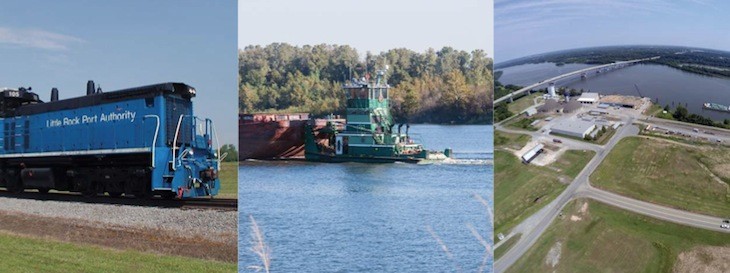Little Rock river port’s economic impact tops $5 billion over past decade, study says
by April 6, 2017 4:41 pm 731 views

The Port of Little Rock has generated nearly $5.1 billion in economic activity in central Arkansas in the last decade and contributed almost $2.5 billion in gross regional product (GRP) to the local economy over the same period, according to a study commissioned by the authority’s board of directors.
Bryan Day, executive director of the Little Rock Port Authority (LRPA), told Talk Business & Politics on Thursday (April 6) that the authority’s board of directors hired Little Rock-based Boyette Strategic Advisors in the spring of 2016 to calculate the true economic impact of the Arkansas River port on the city and Central Arkansas.
“When I came out here, everyone always talked anecdotally about what an important facility this was and what it meant to the economy, and how many people worked here, and taxes and infrastructure and all those economic indicators, but there was no analysis or economic report,” said Day, who was hired by LPRA in July 2014.
Given its charge, the Little Rock consulting firm’s analysis was based on direct effects that capture the change in final demand of directly impacted industries; indirect effects to identify business-to-business spending and induced effects of increased household spending.
“What we found was that over the last 10 years, we (Little Rock port) had a $5.1 billion impact,” Day said. “We realized when the report was done that we are not the largest economic engine in the state by any means, but if you look at everything and the impact on the local community that this port has, it plays a significant role …”
The Central Arkansas port is part of the 448-mile McClellan-Kerr river shipping lane that runs from the Mississippi River northwest to 15 miles east of Tulsa, Okla. The three-state river navigation system includes 18 locks, shipping 12 million tons annually with a cargo value of $3.9 billion.
Facilities at the Little Rock port provide access to the Arkansas River levee and docking facilities where the 2,600-acre industrial port has more 40 active businesses that employ more than 3,500 workers. In addition, the Union Pacific Railroad and the BNSF serve the Port of Little Rock’s switching railroad, handling more than 10,000 cars yearly. The port is also near Interstates 30 and 40 is also within five miles of the river port, which ships goods and products from Arkansas and the regional manufacturers that cater to global markets.
Besides the newly released economic impact study, LRPA also has recently completed its 2016 annual report. (Link here for the PDF of the report.) The authority’s first-ever annual report was released in 2015.
Following are some of the findings of the economic impact study.
• Port Water and Rail Operations
The operations of the River Port and the LRPA Railroad had an impact of $38 million and made a contribution of nearly $19 million to the Gross Regional Product (GRP) of the City of Little Rock between 2005 and 2015. As part of this contribution, the operations of the Port supported 123 jobs in the city with a combined payroll of $9.1 million over 10 years.
• Facility Construction and Investment at the Park
During 2005-2015, more than $143.8 million was invested in construction projects at the Park. The Little Rock economy benefitted more than $124 million from those construction projects, beyond the initial investment of $143.8 million, for a total impact of $222 million. In addition to contributing more than $124 million to the city’s GRP, construction activity at the Park supported 1,539 jobs. State and local taxes generated as a result of construction at the Park in the ten-year span total more than $4.7 million for the Little Rock study area.
• Employment at Little Rock Port Industrial Park
One of the most significant contributions the Port of Little Rock makes to the City of Little Rock and Pulaski County is the workforce employed by companies and facilities located in the Park. It is estimated that 3,298 were employed in the Park in 2015, an increase from 1,652 in 2005. More than $1.8 billion has been contributed to the Little Rock GRP by facilities at the Park from 2005 to 2015 resulting in a total impact of $4.1 billion. Total payroll for this time period was nearly $900 million and state and local taxes generated were more than $135 million.
• Infrastructure
The same decade saw $33.5 million has been invested in infrastructure. Spending on infrastructure created an impact of more than $25 million to the Little Rock economy. Over the measured time period, nearly 300 infrastructure jobs were supported with a total payroll of $18 million
